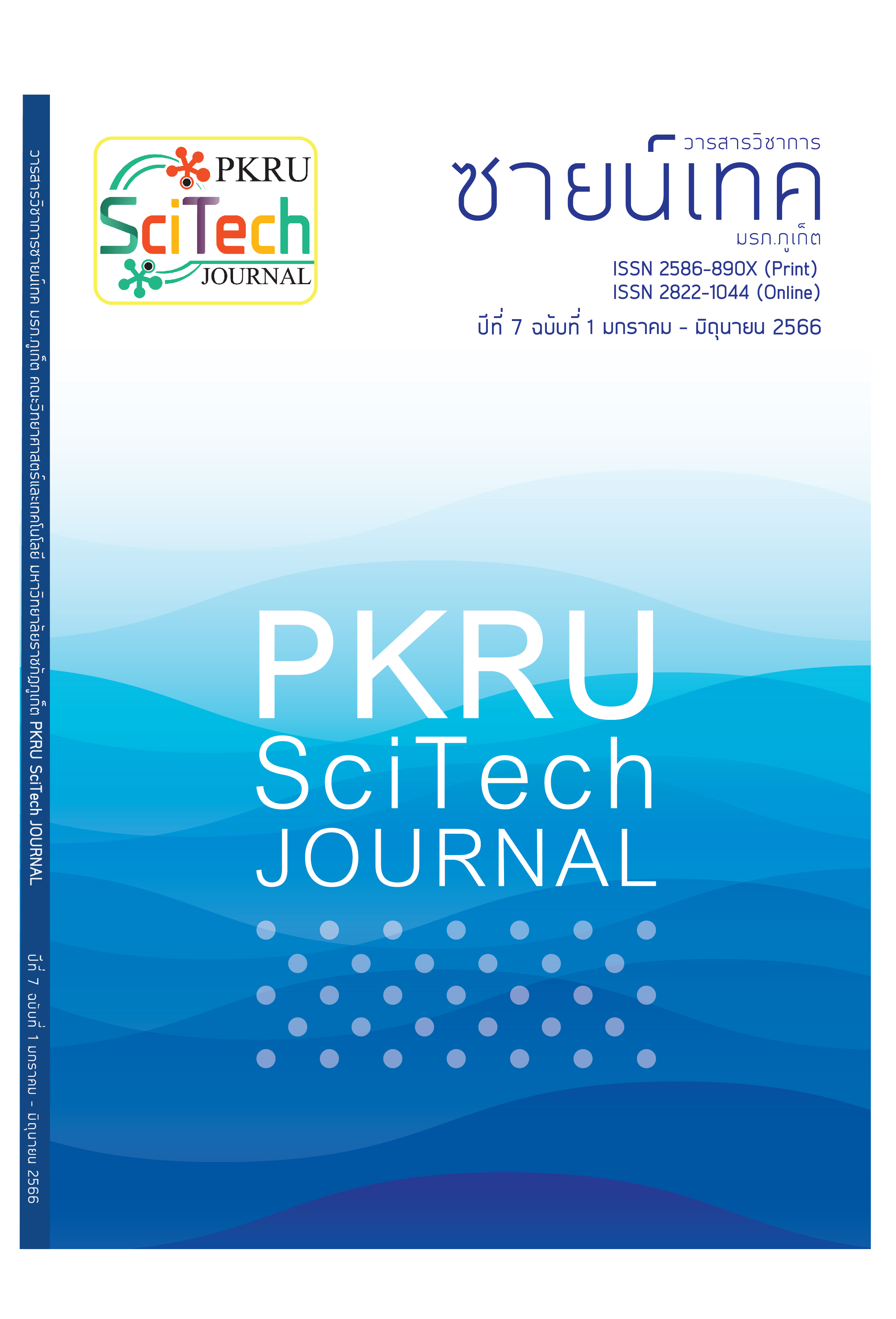Coral Recruitment in Patong Bay, Phuket Province
Main Article Content
Abstract
We compared newly settled larvae and growth of juvenile colonies on various substrates consisting of settlement tiles, coral reef, and artificial substrate in Patong Bay Phuket, Thailand. The study was conducted during January to May 2019. There were 7 stations in both reef flat and reef slope locations to cover the north Patong and the south Patong Bay areas. Settlement tiles were used to study coral larval settlement and 1 x 1 m quadrates were used to investigate settlement of juvenile corals on the natural substratum and on artificial reef material of various shapes (2015-2016). Settlement tiles were set out for 4 months. The number of recruits on the settlement tiles in each station were significantly different (P< 0.05). Settlement numbers were 12.86 to 27.01 colonies/m2. Whilst on the natural substratum and the artificial reef material, there was no difference among the stations and shape of the artificial reef material (P>0.05). Colony recruitment was 1.17 to 2.08 colony/m2 and 55.6 to 71.1 colony/m2 of juvenile corals on the natural and artificial reefs respectively. Even though the reefs of Patong Bay were in generally poor condition, recruitment was still good and so the reefs have potential to recover if longer term living conditions on them was better. Although recruitment was limited for the natural substratum, significant recruitment did occur on the cleaner artificial substratum. Thus, artificial reef material may be suitable to restore the Patong reefs and improve habitat quality, especially in South Patong.
Article Details

This work is licensed under a Creative Commons Attribution-NonCommercial-NoDerivatives 4.0 International License.
- The original content that appears in this journal is the responsibility of the author excluding any typographical errors.
- The copyright of manuscripts that published in PKRU SciTech Journal is owned by PKRU SciTech Journal.
References
วิภาวี ดำมี, พงศ์ธีระ บัวเพ็ชร, และ สุขศิริ ชูกลิ่น. (2562). ความหลากชนิด สถานภาพ และการลงเกาะของตัวอ่อน ของปะการังในอ่าวป่าตอง จังหวัดภูเก็ต. รายงานการวิจัย. กรุงเทพฯ: สำนักงานพัฒนาเศรษฐกิจจากฐานชีวภาพ (องค์การมหาชน).
Department of marine and coastal resources ministry of natural resources and environment. (2005). Rapid assessment of the Tsunami impact on marine resources in the Andaman Sea, Thailand. Bangkok: Phuket Marine Biological Center.
กรมทรัพยากรทางทะเลและชายฝั่ง. (2562). ปะการังฟอกขาว. [ออนไลน์], สืบค้นจาก: https://km. dmcr.go.th/th/c_254/d_18836 (28 สิงหาคม 2562).
Phongsuwan N., & Chansang H. (2012). Repeated coral bleaching in the Andaman Sea, Thailand, during the last two decades. Phuket Marine Biological Center, 71, 19-41.
Edwards, A., & Gomez, E. (2007). Reef Restoration Concepts and Guidelines: making sensible management choices in the face of uncertainty. Australia: Coral Reef Targeted Research & Capacity Building for Management Program.
Sawall Y., Phongsuwan, N., & Richter, C. (2010). Coral recruitment and recovery after the 2004 Tsunami around the Phi Phi Islands (Krabi Province) and Phuket, Andaman Sea, Thailand. Helgoland Marine Research, 64, 357-365.
Gleason, D. F., & Hofmann, D. K. (2011). Coral larvae: from gametes to recruits. Journal of Experimental Marine Biology Ecology, 408, 42-57.
Ruppert, E. E., Fox, R. S., & Barnes, R. D. (2004). Cnidaria. In Invertebrate zoology: a func tional evolutionary approach. (pp. 124-147). Singapore: Thomson Learning Inc.
Bauman, A. G., Guest, J. R., Dunshea, G., Low, J., Todd, P. A., & Steinberg, P. D. (2015). Coral settlement on a highly disturbed equatorial reef system. PLoS One, 10, 127-874.
กรมทรัพยากรทางทะเลและชายฝั่ง. (2558). คัมภีร์ทรัพยากรทางทะเลและชายฝั่งของไทย 2558.กรุงเทพฯ: สำนักพิมพ์ชุมนุมสหกรณ์การเกษตรแห่งประเทศไทย จำกัด.
สุขศิริ ชูกลิ่น, วิภาวี ดำมี, ทนงศักดิ์ จันทร์เมธากุล และ พงศ์ธีระ บัวเพ็ชร. (2562). ความหลากชนิด และสถานภาพแนวปะการัง ในอ่าวป่าตอง จังหวัดภูเก็ต (หน้า 2947-2956). ใน การประชุมทางวิชาการระดับชาติ มหาวิทยาลัยเกษตรศาสตร์ วิทยาเขตกำแพงแสน ครั้งที่ 16. นครปฐม
English, S., Wilkison, C., & Baker, V. (1997). Survey manual for tropical marine resources. Australia: Australian Institute of Marine Science.
Babcock, R. C., Baird, A. H., Piromvaragorn, S., Thomson, D. P., & Willis, B. L. (2003). Identification of scleractinian coral recruits from Indo-Pacific reefs. Zoological Studies, 42(1), 211-226.
Baird, A. H., & Babcock, R. C. (2000). Morphological differences among three species of newly settled Pocilloporid coral recruits. Coral Reefs, 19, 179-183.
กรมทรัพยากรทางทะเลและชายฝั่ง. (2559). วิธีการสำรวจและเก็บตัวอย่างในระบบนิเวศแนวปะการัง (พิมพ์ครั้งที่ 1). กรุงเทพฯ: ห้างหุ้นส่วนจำกัด สิทธิโชค พริ้นติ้ง.
นิพนธ์ พงศ์สุวรรณ. (2564). คู่มือจำแนกชนิดปะการังในน่านน้ำไทย. กรุงเทพฯ: สถานบันวิจัยและพัฒนาทรัพยากรทางทะเลและชายฝั่ง กรมทรัพยากรทางทะเลและชายฝั่ง
Zar, J. H. (2014). Biostatistical Analysis: Pearson New International Edition (5th edition). England: Pearson Education Limited.
Salinas-de-León, P., Costales-Carrera, A., Zeljkovic, S., Smith, D. J., & Bell, J.J. (2011). Scle-ractinian settlement patterns to natural cleared reef substrata and artificial settlement panels on an Indonesian coral reef. Estuarine, Coastal and Shelf Science, 93(1), 80-85.
Woesik, R. V., Scott, W. J., & Aronson, R. B. (2014). Lost opportunities: Coral recruitment does not translate to reef recovery in the Florida Keys. Marine Pollution Bulletin, 88(1-2), 110-117.
Babcock, R., & Mundy, C. (1996). Coral recruitment: Consequences of settlement choice for early growth and survivorship in two scleractinians. Journal of Experimental Marine Biology and Ecology, 206(1-2), 179-201.
Fox, H. E. (2004). Coral recruitment in blasted and unblasted sites in Indonesia: assessing rehabilitation potential. Marine Ecology-Progress Seriesm, 269, 131-139.
Thongtham, N., & Chansang, H. (1999). Influence of surface complexity on coral recruitment at Maiton Island, Phuket, Thailand. Phuket Marine Biological Center, 20, 93-100.
Joana, F, Andrew H. B., & Sean, R. C. (2013). Synthesizing larval competence dynamics and reef-scale retention reveals a high potential for self-recruitment in corals. Ecology, 94(3), 650-659.
Klinthong, W., Sutthacheep, M., Aunkhongthong, W., Rongprakhon, S. Ruangthong, C., & Yeemin, T. (2021). Abundance of coral recruits on settlement plate experiments from Mu Ko Angthong, the Western Gulf of Thailand. Ramkhamhaeng International Journal of Science and Technology, 4(2), 19-27.

